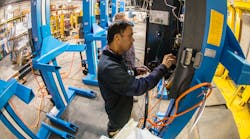To keep your shop running most efficiently, the ultimate goal is to purchase lifts that will be safe, dependable and durable for your facility. These important factors should play a role in your decision-making process.
Key factors to consider
When choosing a lift for your fleet maintenance facility, what key factors are most important?
Many may consider cost as one of the key factors when making a lift purchasing decision. It is important to consider cost beyond the initial purchase of the equipment. Some additional factors to consider include:
- Is the lift you’re purchasing ALI certified?
- Does it come with a warranty?
- Is there a service plan available?
- Do they offer tech support?
- Are parts readily available?
- How long will it take to complete service/repair work on your lift?
“There is nothing worse than spending money on a piece of equipment to make your maintenance shop run profitably and efficiently, and then having it break down with no after-sales support,” says Allister Collings, President, SLEC, Inc.
Many lift manufacturers provide after-sale service options such as extensive product warranties, free technical phone support and customized service plans.
Collings says SLEC provides service plans tailored to the shop’s needs, from annual inspections to fixed-cost all-in plans which cover all parts and costs associated with non-scheduled breakdowns.
When making a decision on a lift purchase, also consider safety certification. Look for the Automotive Lift Institute’s (ALI) Gold Label to verify third-party certification.
The governing standard of vehicle lifts, ALI provides an independent, third-party certification program that promotes the safe design, construction, installation, inspection and use of vehicle lift products. With seven different types of lifts commonly used in today’s fleet maintenance facilities, it is important to check the ALI website to see if the lift you plan to purchase is ALI certified first.
Read the manual
It is important for safe lifting practices to receive proper training on how to use your specific lift.
You should always follow the manufacturer’s instructions and policies on how to correctly operate your lift. The manual should include important procedures regarding:
- Weight capacity
- Transportation and unloading
- Safety
- Installation
- Operation
- Troubleshooting
- Maintenance
Most importantly, the manual should include contact information for the manufacturer.
Routine safety checks
Making sure your staff goes home safely at the end of each work day should be a priority for your fleet maintenance facility. That’s why it’s important to complete daily safety checks on your lift before operating.
“Each lift manufacturer will have different safety checks for their lifts,” Allister says. “The safety check is quick, but essential. Daily safety checks for SLEC mobile column lifts include cables, plug, limit switch and the protection band. These items should be inspected daily for damage as they are components to the safe operation and longevity of the lift.”
If there are any items on your daily safety checklist that are damaged, it is recommended that the item is replaced immediately to ensure your lift continues to run safely.
Annual inspections
Current OSHA requirements and the latest ALI/ANSI standards state that all vehicle lifts should be inspected on an annual basis. Having your lift inspected annually ensures the essential components of your lifts are operating safely and correctly. Ultimately, this reduces possible downtime of your lift due to malfunctions, and supports the continued safety of your staff.
A lift technician completing an annual inspection should check all key lift components for signs of wear or damage. When the inspection is complete, you will receive an OEM Inspection Report confirming the safe operation and working conditions of your lift. If required, an outline of recommended corrective action can also be provided.
Jamie Pedrick is the Marketing Director at SLEC, Inc., and has been with the company for nine years. She is also pursuing her Marketing and Visual Productions degree from Cecil College.



